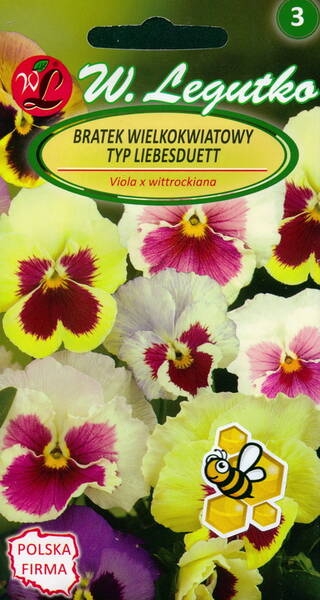A mixture of romantic colours!
Sowing time: June, July.
Planting seedlings: August, September.
Flowering: May, June, July, August, September.
Planting method: seedlings. Plant height: about 15 cm.
Distance between plants: 25 cm.
Distance between rows: 20 cm.
Use for flower beds and borders, in flower beds - in groups.
At a temperature of +18°C, the time from sowing to germination is 10-15 days.

Marty Bell.
Eng.: Garden Pansy. Suom.: Tarhaorvokki. Sven.: Pensé.
* In the first half of the 19th century in England, thanks to the gardener Thompson, who was lucky enough to find and bring a wild variety of violet, similar, in his words, to a "cunning cat's face", active selection and introduction of pansies into gardens and parks began.
Viola tricolor (Viola tricolor) began to be crossed with yellow violet (Viola lutea), Altai (Viola altaica) and horned violet (Viola cornuta), resulting in many new varieties and hybrids.
Hybrid plants differed so much from the original species that it became necessary to isolate them into a new, artificially obtained species - Wittrock's violet (Viola x wittrokkiana).
The name is given in honour of the Swedish botanist Veit Wittrock (1839-1914), who devoted his entire life to studying this plant.
In England, pansies are still one of the most beloved plants (even when leaving for other countries, the British try to plant these cheerful flowers in their new front gardens as a memory of their homeland).
Viola always occupies one of the most important positions in the world production of seeds and seedlings. Fashion trends concern only varieties, but not culture as a whole. After all, in many respects, she has no equal both in landscaping and in private floriculture.
Viola blooms almost any time. It is cold-resistant, unpretentious, grows in the sun and in partial shade, tolerates transplanting well in a flowering state.
A variety of varieties allows the use of culture in regular and landscape flower beds of any style, as well as in container decor, including on balconies and windows.
And the richest range of colours, nuances of colours and amazing charm of these velvety violets attract people of all ages and classes.
In classical floriculture, Wittrock's viola is a biennial that, depending on the timing of sowing and planting in the ground, blooms at any time of the year.
And according to biological features, this is a perennial plant, which after 2 years of culture continues to grow, but loses its decorative value.
In Europe, viola is used in early spring and autumn-winter flower beds. Accordingly, there are two terms for the production of seedlings.
For early flowering (mid-February-March), the crop is sown in the fall, and for planting in the garden in September, sowing is carried out in the summer.
This circumstance is necessarily taken into account in modern breeding: some companies divide the assortment by season, while others strive to create universal cultivars (this parameter is indicated in the variety characteristics in the catalog).












